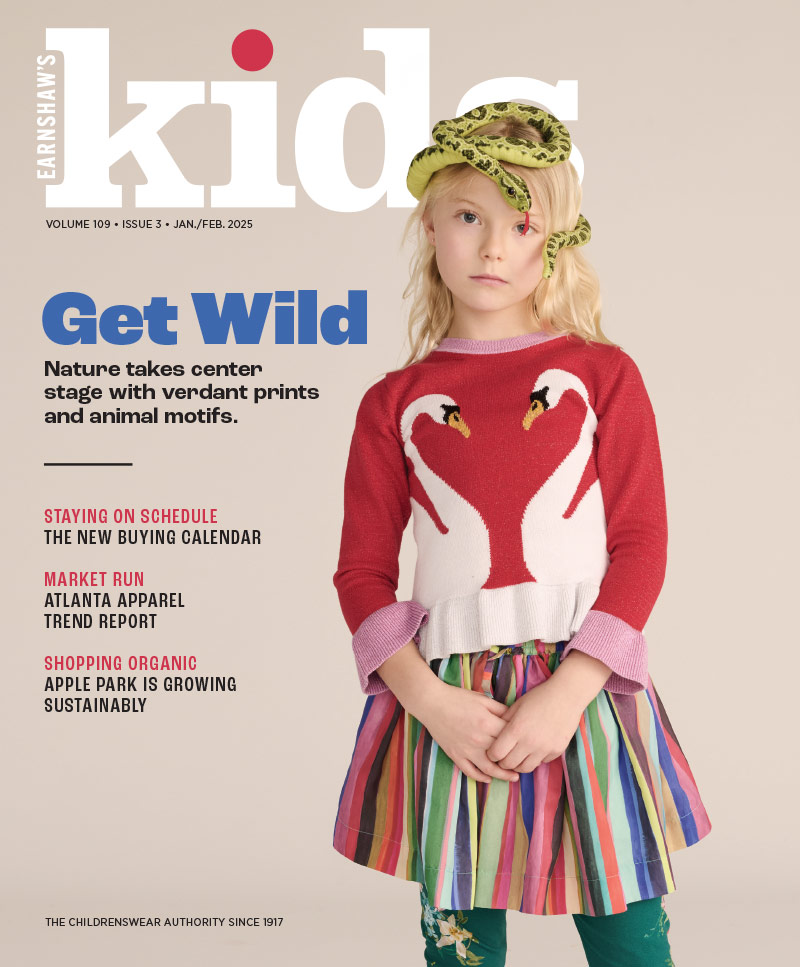As women from the millennial set enter motherhood, catering to the tech-savvy crowd has become more important than ever. By Samantha Sciarrotta Lately, it feels like nary a newscast or magazine cover goes by without mentioning the word “millennial.” The demographic is everywhere, whether it’s being (perhaps unfairly) declared selfish by Time or praised for […]
As women from the millennial set enter motherhood, catering to the tech-savvy crowd has become more important than ever.
By Samantha Sciarrotta
Lately, it feels like nary a newscast or magazine cover goes by without mentioning the word “millennial.” The demographic is everywhere, whether it’s being (perhaps unfairly) declared selfish by Time or praised for its connection to growth, development and technology. And retailers should take note: Millenials, also known as Generation Y, account for over $170 billion worth of purchasing power per year, according to a January 2012 ComScore report. And one group within the demographic keeps on growing: Moms. Almost 83 percent of new moms are millennials, according to a survey by BabyCenter.com, and, as experts place the group in the 14 to 32 age range, that number will only continue to increase, as women on the younger end of the spectrum grow up.
But as society evolves and technology gets more and more advanced, the millennial mom is experiencing parenting like no other generation before, especially when it comes to shopping. (And that includes dads, too: Ryan Lafrenz, founder of organic cotton baby line AXL Brand, says his collection has seen a steady increase in sales to men in the millennial age range, and he expects it will continue to rise.) Entire wardrobes can be purchased with a single click, and product reviews can be found or shared in an instant. As a result, consumer knowledge is at an all-time high, says Shane Guidry, the buyer for New Orleans boutique Pippen Lane. “Because of the Internet and mom blogs, consumers know everything,” she points out. “They know the products almost as fast as the buyers know the products.”
So what’s the key to cracking this constantly-connected cohort? Here, an array of children’s retailers and manufacturers spill the secrets to selling to Generation Y.
Living Social
Their proclivity to peruse sites like Pinterest, Twitter, Facebook and Instagram has made it almost impossible to not associate millennials with social media. For brands and stores, a social network presence has essentially become a requirement in the last decade—and it’s largely due to the online habits of this generation. The networks keep on growing in popularity, especially with moms ages 18 to 32, as noted by eMarketer: Eighty-six percent of millennial moms regularly use Facebook, while 58 percent use YouTube, 46 percent are on Pinterest, 30 percent have Instagram accounts and 13 percent tweet. Spending 17.4 hours per week on social networks, milliennial moms are more active than older moms by about four hours a week, says a Weber Shandwick study, which also found that they have, on average, 3.4 social media accounts each, as opposed to the 2.6 maintained by moms overall. “Social media can be the driving force in the success of many emerging and established brands, and millennial moms have shown that they’re extremely savvy when it comes to social media and
networking,” notes Lafrenz. “We’ve seen the most active followers on our social media platforms fall into this demographic.”
And with 23 percent of moms posting on social media about recent buys, according to eMarketer, they’re not afraid to go public about a purchase. The Weber Shandwick study found millennial moms “like” or recommend products or services on networks like Facebook an average of 10.4 times per month. “Because of their activity on the various social media platforms, we feel they’re searching for something unique and noteworthy, be it a limited run or emerging brand,” Lafrenz discloses. “We all love to feel like we’re a part of something new or exclusive.”
And millennial moms love to share those finds with their friends, says Rebecca Weisz, owner of Ladida, a Lakewood, NJ boutique. “These moms share their ideas and photos with one another, creating a community where everyone is having fun and shopping together,” she reflects.
Get Wired In
In a broader sense, the Internet as a whole is also a major part of a millennial mom’s daily routine, especially when it comes to shopping. They’re busy, they’re active and they want a painless shopping experience, says Lindsay Meyer-Harley, owner of Darling Clementine, an online children’s boutique. “Shopping online is just so easy,” she points out. “We’re all so busy. Who has time to browse the racks at the mall?” Which is why many moms comb through products on their computers (83 percent) and smartphones (58 percent), according to eMarketer. And, as a Barkley study shows, 50 percent even use their smartphones to research products or services while they’re out shopping. “They’re very savvy,” notes Elizabeth Crosby, founder of online shop Wee Mondine. “They do a lot of their shopping online so they can see what other stores are charging for merchandise.”
Building a website to complement your physical store can be invaluable when it comes to capturing dollars from millennial moms, Weisz notes. “Our online store is a way to bring our curated collection far beyond the walls of our brick-and-mortar store,” she adds. And what’s the best way to drive Generation Y customers to your site? It all goes back to social media. “We love that we can post something on Instagram and our followers can have it with the click of a button,” Weisz points out. “Millennial moms are probably the largest consumer group at our store and on our website. These are the moms who are Facebooking, Instagramming and networking in these ways with other moms. They create friendships and bond while discussing parenting tips, recipes and definitely children’s fashion. They are finding us through those channels and becoming great customers who keep coming back.”
But look beyond social networks and e-commerce sites to tempt the demographic: E-mail marketing campaigns and loyalty programs are also important to keeping the millennial customer around. So important, in fact, that over 95 percent of them polled in a June 2013 Accenture study expressed a desire for brands to actively court them using those methods. A 2011 Aimia study found similar results: Seventy-seven percent of millennial consumers participate in loyalty and reward programs, and 78 percent stated that they were more likely to choose a brand that offered rewards over one that didn’t.
Focus on Functional Fashion
As more moms discover more brands at a rapid pace, they’re able to choose from a massive selection of styles, crafting the perfect wardrobe for their kids that is as functional and wearable as it is fashionable. “Millennial moms place more emphasis on the combination of design and the look and feel of products,” notes Carolina Toro-Gerstein of nursing cover line Poncho Baby. “They want products that are attractive and catch the eye without sacrificing functionality.” As Crosby notes, dressing their little ones has become something of a creative outlet for millennials. With clever prints on items like soft leggings and cotton tees, Crosby cites brands like Mini Rodini and Indikidual as some of her favorites for young moms. “Today’s mom is a little more interested in kids’ clothes, where they come from and how they fit a particular style,” she shares. “They’re catching on to the new idea that kids can really express themselves through clothes.” Guidry agrees, noting funky graphic T-shirts and leggings by Zara Terez are top sellers at her Big Easy boutique, while Weisz adds that brands who utilize the aesthetic Crosby described, like Bobo Choses, Nununu and Bang Bang Copenhagen, are all hot among the millennial set. Added bonus: Many of those brands provide a gender-neutral look, which is another quality millennial moms crave. “A lot of the funkier stuff is looking more gender-neutral,” says Stephanie Goldstein of New York City-based boutique Stoopher & Boots. “People are moving towards wanting less girly, less frilly items.” Crosby, who prefers the unisex look for her own children, seconds that notion: “We’re seeing a move away from the traditional pink and blue,” she adds.
Essentially, millennials want to dress their little ones the way they dress themselves, and with brands like Splendid and Ella Moss that cater both to kids and adults, that’s entirely possible. “These days, it seems more and more moms like to dress their kids in clothing that they’d wear if it came in their size,” Meyer-Harley points out. “I’m the same way. If I’d wear it, chances are I’d like my kids to rock it, too.” Guidry says the same, noting that Pippen Lane’s customers of all ages don Splendid and Ella Moss as well as footwear brands like Toms. It’s a reflection of brand familiarity, she states. “They go to what they know and trust. They can see these brands anywhere, whether they’re looking in a brick-and-mortar store or online.” In fact, an Adroit Digital survey found that 64 percent of millennials felt that they were more loyal to brands than their parents. And with the same percentage of female respondents claiming they felt the greatest brand loyalty to clothing, shoe and accessory lines, it’s especially true with apparel.
Customer Service is Still Key
No matter if millennials are browsing the web or the racks, customer service is king when it comes to keeping them around. Due to services like Yelp, employees of physical stores and e-tailers alike have to be on their best behavior, says Guidry of Pippen Lane. “As a mom, customer service is key for me, and it’s key for millennials, too,” she notes. “Now you can go on any website and give your review. Customer service is still big, whether you’re ordering from Zappos or looking for personal touches from a brick-and-mortar store.” Bonds are important, too, says Weisz. “They want to form relationships with the shops and feel like they are being well-catered to,” Weisz observes. “We really try to create that feeling for them.” Crosby shared a similar sentiment. “They don’t have a lot of time,” she offers. “They want things to be really fun and easy. I also think they want to be inspired.” Stocking special pieces can do just that, says Meyer-Harley. “They want one-of-a-kind pieces that blend into their children’s wardrobe. They want to feel like they’ve been searching for the perfect items without doing the legwork,” she says. “They look to shop owners whose eye they trust.”




 From milestones to everyday magic, @ryleeandc
From milestones to everyday magic, @ryleeandc

 BEST IN SHOW: @milaandrose
Twirl-worthy, pla
BEST IN SHOW: @milaandrose
Twirl-worthy, pla





 This season’s
This season’s

 We had an i
We had an i


 Make Your Message Unmissable in 2025!
Get ahea
Make Your Message Unmissable in 2025!
Get ahea





 F
F



Leave a Comment: